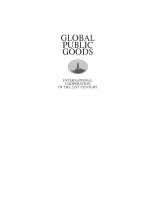GLOBAL PUBLIC GOODS INTERNATIONAL COOPERATION IN THE 21ST CENTURY pot
Bạn đang xem bản rút gọn của tài liệu. Xem và tải ngay bản đầy đủ của tài liệu tại đây (3.29 MB, 585 trang )
GLOBAL
PUBLIC
GOODS
INTERNATIONAL
COOPERATION
IN THE 21ST CENTURY
“It is not beyond the powers of political volition to tip the scales towards more
secure peace, greater economic well-being, social justice and environmental
sustainability. But no country can achieve these global public goods on its
own,and neither can the global marketplace.Thus our efforts must now focus
on the missing term of the equation: global public goods”.
Kofi Annan
Secretary-General of the United Nations
New York
1 March 1999
GLOBAL
PUBLIC
GOODS
INTERNATIONAL
COOPERATION
IN THE 21ST CENTURY
EDITED BY
INGE KAUL
ISABELLE GRUNBERG
MARC A. STERN
PUBLISHED FOR
THE UNITED NATIONS DEVELOPMENT PROGRAMME
(UNDP)
NEW YORK OXFORD
OXFORD UNIVERSITY PRESS
1999
Oxford University Press
Oxford New York
Athens Auckland Bangkok Bombay
Calcutta Cape Town Dar es Salaam Delhi
Florence Hong Kong Istanbul Karachi
Kuala Lumpur Madras Madrid Melbourne
Mexico City Nairobi Paris Singapore
Taipei Tokyo Toronto
and associated companies in
Berlin Ibadan
Copyright © 1999
by the United Nations Development Programme
1 UN Plaza, New York, New York, 10017, USA
Published by Oxford University Press, Inc.
198 Madison Avenue, New York, New York, 10016
Oxford is a registered trademark of Oxford University Press
All rights reserved. No part of this publication may be reproduced, stored in a retrieval
system or transmitted, in any form or by any means, electronic, mechanical, photo-
copying, recording or otherwise, without prior permission of Oxford University
Press.
Library of Congress Cataloging-in-Publication Data
Kaul, Inge
Global public goods: international cooperation in the 21st century/ edited by Inge
Kaul, Isabelle Grunberg, Marc A. Stern.
p. cm.
Includes bibliographical references and index.
ISBN 0-19-513051-0 (cloth). — ISBN 0-19-513052-9 (paper)
1. Public goods. 2. International cooperation. I. Kaul, Inge. II. Grunberg, Isabelle
III. Stern, Marc A.
HB846.5.G55 1999
363—DC21 99-10940
CIP
Rev.
Cover and design: Gerald Quinn, Quinn Information Design, Cabin John, Maryland
Editing and production management: Communications Development Incorporated,
Washington, D.C.
“With the publication of this volume, UNDP has again proved to be a leading
intellectual agency, as well as an important operational body”.
Kazuo Takahashi
Director
International Development Research Institute
Tokyo
“This volume introduces a framework for facilitating and reinforcing interna-
tional development through an equal partnership model of cooperation. I find
it enlightening, and hopefully reflective of the changing values of this era”.
Ismail Razali
Chairman
Central Bank of Malaysia
“This book embarks into new dimensions of thinking.”
Klaus Schwab
President
World Economic Forum, Davos
“We need better international cooperation to ensure that human beings have
full access to necessary public goods. This volume is an invaluable tool to bring
this goal closer”.
Paul Kennedy
Yale University
“How can self-interest be harnessed for the public good? This volume will prove
useful to anyone interested in answering that question”.
Jose Goldemberg
Former Minister of the Environment, Brazil
“At a time when many are saying that globalization has gone too far, UNDP has
produced a wide and deep study of global public goods. The volume deals with
peace and trade, but also with global warming, transnational pollution, disease
and financial crises—all public bads—and their suppression, which constitutes
a good. The subject is complex but of paramount importance to a world expe-
riencing, or approaching, multidimensional crises”.
Charles Kindleberger
Massachusetts Institute of Technology
“This volume is bound to be an important reference for future work and
public debate”.
Ralph C. Bryant
The Brookings Institution
“This is an important piece of work on one of the most interesting and urgent
problems of our time. An increasing number of issues, including those of the
developing world, are an international responsibility. This volume does a dis-
tinctively important service by drawing this fact to our attention. I admire the
effort that has gone into it. I particularly endorse the result”.
John Kenneth Galbraith
Harvard University
“The concept of public good offers a useful analytical framework for the con-
tinuing debate over the usefulness of aid because, among other things, of its
focus on the mutuality of benefits. In particular, regional public goods must be
a critical part of the strategy for Africa’s growth and development and for
improving Africa’s competitiveness”.
Kwesi Botchwey
Former Minister of Finance, Ghana
CONTENTS
PROLOGUE x
Tommy Koh
FOREWORD xii
James Gustave Speth
ACKNOWLEDGEMENTS xv
C
ONTRIBUTORS xvii
I
NTRODUCTION xix
Inge Kaul, Isabelle Grunberg and Marc A. Stern
CONCEPTS 1
DEFINING GLOBAL PUBLIC GOODS 2
Inge Kaul, Isabelle Grunberg and Marc A. Stern
I
NTERGENERATIONAL PUBLIC GOODS:
S
TRATEGIES, EFFICIENCY AND INSTITUTIONS 20
Todd Sandler
T
HE POLITICAL ECONOMY OF INTERNATIONAL COOPERATION 51
Lisa L. Martin
CASE STUDIES 65
E
QUITY AND JUSTICE 66
EQUITY IN A GLOBAL PUBLIC GOODS FRAMEWORK 68
J. Mohan Rao
D
ISTRIBUTIVE JUSTICE AS AN INTERNATIONAL PUBLIC GOOD:
A H
ISTORICAL PERSPECTIVE 88
Ethan B. Kapstein
G
LOBAL JUSTICE: BEYOND INTERNATIONAL EQUITY 116
Amartya Sen
vii
MARKET EFFICIENCY 126
DEEP INTEGRATION AND TRADE AGREEMENTS:
G
OOD FOR DEVELOPING COUNTRIES? 128
Nancy Birdsall and Robert Z. Lawrence
I
NTERNATIONAL FINANCIAL INSTABILITY 152
Charles Wyplosz
ENVIRONMENT AND CULTURAL HERITAGE 190
MONTREAL VERSUS KYOTO:
I
NTERNATIONAL COOPERATION AND THE GLOBAL ENVIRONMENT 192
Scott Barrett
N
EW STRATEGIES FOR THE PROVISION OF GLOBAL PUBLIC GOODS:
L
EARNING FROM INTERNATIONAL ENVIRONMENTAL CHALLENGES 220
Geoffrey Heal
C
ULTURAL HERITAGE AS PUBLIC GOOD:
E
CONOMIC ANALYSIS APPLIED TO HISTORIC CITIES 240
Ismail Serageldin
HEALTH 264
GLOBAL EPIDEMIOLOGICAL SURVEILLANCE:
I
NTERNATIONAL COOPERATION TO MONITOR INFECTIOUS DISEASES 266
Mark W. Zacher
H
EALTH AS A GLOBAL PUBLIC GOOD 284
Lincoln C. Chen, Tim G. Evans and Richard A. Cash
KNOWLEDGE AND INFORMATION 306
KNOWLEDGE AS A GLOBAL PUBLIC GOOD 308
Joseph E. Stiglitz
G
LOBAL COMMUNICATIONS FOR A MORE EQUITABLE WORLD 326
J. Habib Sy
T
HE PUBLIC FACE OF CYBERSPACE 344
Debora L. Spar
viii
GLOBAL PUBLIC GOODS
PEACE AND SECURITY 364
PREVENTING DEADLY CONFLICT:
F
ROM GLOBAL HOUSEKEEPING TO NEIGHBOURHOOD WATCH 366
David A. Hamburg and Jane E. Holl
P
EACE AS A GLOBAL PUBLIC GOOD 382
Ruben P. Mendez
POLICY IMPLICATIONS 417
INTERNATIONAL PUBLIC GOODS AND THE CASE FOR FOREIGN AID 418
Rajshri Jayaraman and Ravi Kanbur
R
EGIONAL PUBLIC GOODS IN INTERNATIONAL ASSISTANCE 436
Lisa D. Cook and Jeffrey Sachs
CONCLUSION
GLOBAL PUBLIC GOODS: CONCEPTS, POLICIES AND STRATEGIES 450
Inge Kaul, Isabelle Grunberg and Marc A. Stern
GLOSSARY 509
FURTHER READING 512
Compiled by Priya Gajraj
ABOUT THE CONTRIBUTORS 517
INDEX 527
ix
CONTENTS
x
PROLOGUE
I am very pleased to write the prologue to this important volume. I consider
this an important book for three reasons.
First, I believe that the book breaks new ground by extrapolating the
concept of “public goods” from the national level to the global level. The
book makes a convincing argument that the two tests of a public good, non-
rivalry and nonexcludability, can be applied at the global level to such things
as environment,health,culture and peace.In particular,I am persuaded that
financial stability, the Internet and knowledge can be considered as global
public goods.
Second, I agree with the book’s thesis that we live in an increasingly inte-
grated and interlinked world. In this new world, the sovereignty of the state is
changing owing to two opposing developments. On the one hand, states are
forced to cooperate in order to solve their problems. This applies to the envi-
ronment, health, peace, knowledge and, as we have witnessed recently, finan-
cial stability. On the other hand, the trend is towards subsidiarity or the
principle of devolving the power of decision-making to the lowest possible
level.
Third, I think the book makes a persuasive argument for the need to
rethink the nature of international assistance. It is no longer enough to target
international assistance at recipient countries or at specific sectors. The rea-
son is that some global public goods cut across several sectors. How do we
finance global public goods? Are existing institutions adequate? If not, how
should they be reformed? Do we need new institutions? How do we incorpo-
rate into our institutions the ethos of tripartism: government, business and
civil society?
This book seeks to answer these and many other important policy ques-
tions. It provides us with a new intellectual framework with which to think
about international assistance. It also offers a powerful new argument for
increased international cooperation in order to provide the global public
goods that are needed to give globalization a human face.
Professor Tommy Koh
Ambassador-at-Large
Ministry of Foreign Affairs
Singapore
Executive Director
Asia-Europe Foundation
xi
PROLOGUE
FOREWORD
National public goods have been part of the economic theory of government
for centuries. As any student of public policy knows, the idea that society
needs government to overcome the failures of the market in achieving effi-
ciency and equity in the allocation and distribution of resources is hardly new.
It is, moreover, a conservative idea. It assumes that private goods and services
will always constitute the bulk of people’s purchases.Markets must be allowed
to function. Yet some outside party must supply those “collective consump-
tion goods” that society also needs, but which the private sector has inade-
quate incentives to provide.
One might side with Adam Smith in focusing the state, as the provider of
public goods, on a few areas: maintaining the money supply, enforcing prop-
erty rights, promoting competitive markets, providing national defence and
administering justice.Or one might assert that people-centred societies call for
a wide range of publicly supplied goods, from social security, health services
and student aid to public transportation, national parks and food stamps. But
whatever position one takes in the debate,it is widely understood that national
public goods and services are fundamental to people’s well-being and that gov-
ernments and markets must work together to provide them.
This book takes the concept of public goods across the national frontier.
In doing so, it transforms the dimensions of the debate and elevates the con-
cept to a new and urgent plane of importance. The authors start with the
observation that, in many areas of public policy, what were once considered
to be purely national issues now spill across borders and are global in reach
and impact. They suggest that a globalizing world requires a theory of global
public goods to achieve crucial goals such as financial stability, human secu-
rity or the reduction of environmental pollution. Indeed, they point out that
many of today’s international crises have their roots in a serious undersupply
of global public goods.
Consider, for example, the case of global human security. Early in this
emerging discussion, the 1994 Human Development Report analysed threats
to world peace in terms of a series of transborder challenges: unchecked pop-
xii
ulation growth, disparities in economic opportunities, environmental degra-
dation, excessive international migration, narcotics production and traffick-
ing and international terrorism. The report argued that the world needs a new
framework for international cooperation to deal with global threats of this
kind. That argument remains sharply relevant today,as we reflect on how best
to address a range of international public policy issues—from human rights
and health to labour and the environment. A theory of global public goods
would be an essential part of such a new framework, providing a new moti-
vation for a different type of development assistance.
After all,society has always been willing to spend money on national pub-
lic goods. We should be equally willing to pay for global goods that serve our
common interest, be they shared systems of environmental controls, the
destruction of nuclear weapons, the control of transmittable diseases such as
malaria and HIV/AIDS, the prevention of ethnic conflicts or the reduction of
refugee flows. And we should be prepared to finance such goods through
innovative mechanisms based on the principles of reciprocity and collective
responsibility, principles that go beyond the concept of official development
assistance (ODA).
Of course, we still need ODA, reformed and redirected. Its chief purpose
should be to help eradicate extreme poverty through sustainable human
development. In fact, with the wealthiest 20% of humanity now as much as
135 times richer than the poorest 20%,and with poverty spreading in all soci-
eties,but especially in developing countries, there is an urgent need to increase
the level of ODA.
But poverty cannot be stopped if we do not have peace or financial sta-
bility or environmental security. Sustainable human development cannot be
achieved if we do not prevent conflicts, manage markets wisely or reverse the
depletion of soils,energy, fresh water and clean air.Equity within and between
generations is not feasible without an international system for identifying and
apportioning environmental costs,for dealing with the destabilizing effects of
weak financial architecture or for helping people everywhere to benefit from
the accumulated stock of global knowledge.The responsibility for and the ori-
gins and effects of such challenges transcend national borders. Beyond ODA,
we therefore need a new form of international cooperation that embraces
trade, debt, investment,financial flows and technology,and that includes pay-
ments and incentives to countries to ensure an adequate supply of global pub-
lic goods. Some ideas on how such a system might be built and financed can
be found in this volume.
FOREWORD
xiii
I expect this book to lend fresh momentum to the debate on the future
of international cooperation in the new millennium. It is a book that deserves
to be read closely and discussed vigorously by all who have a stake in that
future.In a globalizing,increasingly interdependent world,this implies a wide
readership indeed.We all stand to benefit enormously from a world that places
people at its centre and delivers equity, sustainability and peace for genera-
tions to come.
James Gustave Speth
Administrator
United Nations Development Programme
GLOBAL PUBLIC GOODS
xiv
ACKNOWLEDGEMENTS
This volume would not have been possible without the many valuable con-
tributions, comments and suggestions we received from a large number of
individuals and organizations. Special thanks go to James Gustave Speth,
Administrator of the United Nations Development Programme (UNDP),
who challenged us to take a fresh look at the current system of international
cooperation. Throughout, we have benefited from his visionary leadership
and his interest in and commitment to this project.
We would also like to express our gratitude to Eimi Watanabe, Assistant
Administrator and Director of UNDP’s Bureau For Development Policy,for her
unwavering support and substantive comments.We appreciate in particular her
interest in making the analysis relevant to the world’s most vulnerable people.
The contours of the volume emerged from an expert meeting held in New
York in November 1997.Contributors then presented chapter drafts at a meet-
ing in June 1998. We are grateful to the participants in those meetings and
others who shared their ideas and observations with us. We would like to
thank in particular Kwesi Botchwey, Ralph C. Bryant, Richard Cooper, Barry
Eichengreen, Poul Engberg-Pedersen, Marco Ferroni, Albert Fishlow,
Catherine Gwin, Jessica Mathews, Rohinton Medhora, Jean-Claude Milleron,
Sanjay Reddy,Oscar de Rojas,Alfredo Sfeir-Younis,John Sewell,Paul Streeten,
and Klaus Winkel.
We would also like to thank the representatives of UN member states in
New York who made themselves available for consultations on earlier drafts.
The Overseas Development Council has been an intellectual partner through-
out, and in particular initiated the research discussed by Rajshri Jayaraman
and Ravi Kanbur in this volume.
We would especially like to acknowledge the support we received from
Todd Sandler, who was extremely generous with his time and expertise and
who worked tirelessly for a better manuscript. Any flaws that remain in the
text are entirely the responsibility of the editors.
Special thanks are also due to our UNDP colleagues who raised probing
questions and provided thoughtful comments: Adel Abdellatif, Rafeeuddin
xv
Ahmed,Thelma Awori,Jean Barut,Nardos Bekele-Thomas,Neil Buhne,Suely
Carvalho, Berhe Costantinos,Siba Das,Abdoulaye Dieye,Moez Doraid, Gana
Fofang, Fawaz Fokeladeh, Sakiko Fukuda-Parr, Michael Heyn, Nay Htun,
Zahir Jamal, Bruce Jenks, Richard Jolly, Terence Jones, Henning Karcher,
Anton Kruiderink, Normand Lauzon, Roberto Lenton, Carlos Lopes, Elena
Martinez, Peter Matlon, Paul Matthews, Jan Mattsson, Charles McNeill,
Brenda McSweeney, Saraswathi Menon, Achola Pala Okeyo, Minh Pham,
Frank Pinto,Ravi Rajan, Jordan Ryan,Jakob Simonsen,Jerzy Szeremeta,Sarah
Timpson, Mourad Wahba, Ausgustine Zacharias and Fernando Zumbado.
The views expressed here, however, do not necessarily reflect those of UNDP.
We are deeply indebted to Priya Gajraj, whose help in undertaking back-
ground research, editing, trouble-shooting and organizing proved invaluable
at every stage of the volume’s production.
The volume also benefited from the help of Ken MacLeod at Oxford
University Press,the design work of Gerald Quinn,and the editing and prepress
production work of Bruce Ross-Larson and his team at Communications De-
velopment Incorporated. We are most appreciative of the excellent collabora-
tion we received from all of them.
Finally, we are grateful to Flora Aller, Rocio Kattis and Zipora Vainberg-
Rogg, who provided valuable administrative support to our work.
Your comments on this publication would also be highly appreciated.
Please send your observations and other inquiries about the book to UNDP
Bureau of Development Policy/Office of Development Studies (ODS), UH-
401, 336 East 45th Street, New York, NY 10017, USA.
Fax: (212) 906–3676
Email:
GLOBAL PUBLIC GOODS
xvi
CONTRIBUTORS
xvii
SCOTT BARRETT
London Business School
NANCY BIRDSALL
Carnegie Endowment for
International Peace
RICHARD A. CASH
Harvard Institute for International
Development
LINCOLN C. CHEN
Rockefeller Foundation
LISA D. COOK
Harvard University
TIM G. EVANS
Rockefeller Foundation
PRIYA GAJRAJ
United Nations Development
Programme
ISABELLE GRUNBERG
United Nations Development
Programme
DAVID A. HAMBURG
Carnegie Commission on
Preventing Deadly Conflict
GEOFFREY HEAL
Columbia University
JANE E. HOLL
Carnegie Commission on
Preventing Deadly Conflict
RAJSHRI JAYARAMAN
Cornell University
RAVI KANBUR
Cornell University
ETHAN B. KAPSTEIN
University of Minnesota
INGE KAUL
United Nations Development
Programme
ROBERT Z. LAWRENCE
Harvard University
LISA L. MARTIN
Harvard University
RUBEN P. MENDEZ
Yale Center for International and
Area Studies
GLOBAL PUBLIC GOODS
xviii
J. MOHAN RAO
University of Massachusetts,
Amherst
JEFFREY SACHS
Harvard Institute for International
Development
TODD SANDLER
Iowa State University
AMARTYA SEN
Cambridge University
ISMAIL SERAGELDIN
World Bank
DEBORA L. SPAR
Harvard Business School
MARC A. STERN
United Nations Development
Programme
JOSEPH E. STIGLITZ
World Bank
J. HABIB SY
Partners for African Development
CHARLES WYPLOSZ
Graduate Institute of International
Studies, Geneva
MARK W. ZACHER
University of British Columbia
INTRODUCTION
INGE KAUL, ISABELLE GRUNBERG AND MARC A. STERN
We live in a volatile world. New opportunities hold ever-greater promise for
well-being and prosperity. But caught in a web of tension and contradiction,
this world is going through crisis upon crisis.
Economic miracles were hard-won in such places as East Asia; today
financial turmoil and social distress dominate.The end of the Cold War raised
hopes for a lasting peace and a peace dividend; instead,civil strife,conflict and
even genocide have again scarred the landscape. No sooner did people world-
wide begin to enjoy the prospects of a longer and healthier life, when new dis-
eases—and some old ones—took their toll once again and challenged medical
progress. And while technological advances had seemingly freed us from
many natural constraints, including time and space, ecosystems are becom-
ing overloaded with waste and pollution. Meanwhile, the continuing rise in
global inequity, measured by the difference between the world’s poorest and
the world’s richest, places continued strain on the global social fabric. If
today’s trends are allowed to persist, and crises to fester, the promise of a bet-
ter world will recede even further.
Crises are costly. They cause human suffering, strain the environment
and are extremely inefficient—a waste of investments and a drain on future
resources for development. These facts are well known, and they have engen-
dered a growing literature on how to ensure more sustainable growth and
human development.
INTRODUCING GLOBAL PUBLIC GOODS
To understand better the roots of global crises, whether loud (financial
crashes) or silent (poverty), we propose to look at today’s policy challenges
through the lens of global public goods.
First, what is a public good? We know that the marketplace is the most
efficient way of producing private goods. But the market relies on a set of
goods that it cannot itself provide: property rights, predictability, safety,
xix
nomenclature and so on. These goods often need to be provided by nonmar-
ket or modified market mechanisms. In addition, as discussed in our chapter
on “Defining Global Public Goods”, people need both public and private
goods, whether or not they engage in market transactions—peace is a case in
point. Public goods are recognized as having benefits that cannot easily be
confined to a single “buyer” (or set of “buyers”). Yet once they are provided,
many can enjoy them for free. Street names are an example. A clean environ-
ment is another. Without a mechanism for collective action, these goods can
be underproduced.
Or take education, which benefits the person being educated. To calcu-
late the benefits, we take the income a person earns over a lifetime with edu-
cation, and subtract that which she would get without an education. But that
figure does not tell the whole story. What about the numerous employers the
person will have over a lifetime, and the savings realized because these
employers do not have to train her in-house? What about the benefits that lit-
eracy brings to all the companies that rely on the written word to advertise?
The benefits to those who issue public warnings, put out signs or seek to
implement laws? If one were to put a figure on all these benefits, they would
dwarf the amount that accrues strictly to the educated person. This difference
between the public and the private benefits is called an externality. And
because of its substantial externalities, education is a public good.
Financial stability, like many topics covered in this volume, has public
good qualities. A bank or financial institution can generate much profit
through risky lending. All it stands to lose is its capital if it fails. But in a com-
plex and interdependent financial system, the costs of a single institution
defaulting are in fact much higher—often a multiple—because one default
can lead to more failures and defaults.The difference between the private cost
to the bank and the public cost, again, measures the externalities in risky
behaviour—in this example, the negative externalities.
While public goods are understood to have large externalities (and dif-
fuse benefits), a stricter definition relies on a judgement of how the good is
consumed:if no one can be barred from consuming the good,then it is nonex-
cludable. If it can be consumed by many without becoming depleted, then it
is nonrival in consumption.Pure public goods,which are rare,have both these
attributes, while impure public goods possess them to a lesser degree, or pos-
sess a combination of them.
Looking again at education can help us understand why public goods are
difficult to produce in proper quantities. Suppose there are many illiterate
GLOBAL PUBLIC GOODS
xx
people and many eager employers.A person’s first employer would be the one
to shoulder the burden of educating her. But why should that first employer
pay all the costs, while future employers will reap the benefits for free? This
prospect is what might discourage any employer from paying the cost to edu-
cate her workforce. The solution is for all employers to pool resources to
jointly finance education or at least to bridge the gap between the benefits
education brings to the individual—for which she could pay herself—and the
extra benefits they jointly get. But since nonemployers benefit as well, the
whole community is usually brought into this effort.
This, in a simplified form,is the dilemma of providing public goods.And
with globalization, the externalities—the “extra” costs and benefits—are
increasingly borne by people in other countries. Indeed, issues that have tra-
ditionally been merely national are now global because they are beyond the
grasp of any single nation. And crises endure perhaps because we lack the
proper policy mechanisms to address such global public goods. In addition,
the pervasiveness of today’s crises suggests that they might all suffer from a
common cause, such as a common flaw in policy-making, rather than from
issue-specific problems. If so, issue-specific policy responses, typical to date,
would be insufficient—allowing global crises to persist and even multiply.
In applying the concept of global public goods, we look for goods whose
benefits reach across borders, generations and population groups. All public
goods, whether local, national or global, tend to suffer from underprovision.
The reason is precisely that they are public. For individual actors, it is often
the best and most rational strategy to let others provide the good—and then
to enjoy it,free of charge.At the international level,this collective action prob-
lem is compounded by the gap between externalities that are becoming more
and more international in reach, and the fact that the main policy-making
unit remains the nation state.
WHAT THIS BOOK IS ABOUT
Our proposition is that today’s turmoil reveals a serious underprovision of
global public goods. To explore that proposition, we investigate two main
questions. The first is whether—and to what extent—the concept of global
public goods is useful in describing and analysing global challenges. If it is,
the second question is whether we can find feasible policy options and strate-
gies that would apply across the board to ensure a more reliable supply of
global public goods—from market efficiency to equity, health, environmen-
INTRODUCTION
xxi
tal sustainability and peace. Without these global public goods, human secu-
rity and development will be elusive.
HOW THIS BOOK IS STRUCTURED
These questions are investigated in relation to selected areas of global policy
concern, in case studies that form the core of the volume. Brief summaries of
the case studies are provided at the beginning of each cluster of chapters in
the second part of the book. Framing the case studies are two additional sec-
tions, one on concepts, and the other on policy implications.
The first part of the volume sets the stage. The chapter by Kaul, Grunberg
and Stern explores the literature on public goods and provides a definition of
global public goods. Todd Sandler elaborates on intergenerational public
goods, looking in particular at the strategic aspects of their provision and dis-
cussing institutional arrangements for their allocation. Lisa Martin then pre-
sents an overview of current theories of international cooperation, drawing
our attention to the roles of international organizations and nonstate actors
in helping states realise the benefits of cooperation. In this respect, perhaps
the most useful function of international organizations is reducing uncer-
tainty—providing information about the issue at hand and about the prefer-
ences and behaviours of those who have a stake in the issue—states,
nongovernmental organizations and so on.
After the Case Studies, the third part of the volume deals with cross-cut-
ting policy implications. The chapter by Rajshri Jayaraman and Ravi Kanbur
asks the question: when should donor countries fund the provision of global
public goods through aid? They find that aid best contributes to public goods
provision when these goods depend on the “weakest link”. For example, suc-
cess in eradicating a disease such as malaria or smallpox depends on the effort
of the last countries to harbour these diseases. Public goods expenditures in
poor countries are also especially recommended when those countries have a
pivotal role to play in a certain issue-area, as with the preservation of tropical
species, for example. Lisa Cook and Jeffrey Sachs discuss the need for greater
focus on regional public goods, both to provide for the specialized needs of
individual regions and to coordinate regional contributions to global public
goods. Noting the minimal funding currently targeted to the regional level,
Cook and Sachs recommend a number of steps for improving the ability of
international aid organizations to help nations work together towards
regional public goods. Considering the success of the Marshall Plan in
GLOBAL PUBLIC GOODS
xxii
post–Second World War development cooperation in Europe, the authors
suggest that regional development cooperation in the future could follow a
similar model.
A synthesis of all chapters, distilling from them the findings and policy
messages that help answer the book’s two main questions, is presented in the
concluding chapter. There, the reader will also find ample references to indi-
vidual chapters. This has been done in order to link the more general conclu-
sions to concrete findings, and also to show how some of the broader points
apply to particular issue-areas.
WHAT THIS BOOK IS BUILDING ON
We are not starting from scratch. The systematic formulation of the theory of
public goods began with Paul Samuelson’s (1954) “The Pure Theory of Public
Expenditure”. Mancur Olson’s (1971) The Logic of Collective Action analysed
provision problems at length. The application of the concept of public goods
to global challenges started in the late 1960s, especially with Garrett Hardin’s
(1968) “The Tragedy of the Commons”, followed by Bruce Russett and John
Sullivan’s (1971) “Collective Goods and International Organization”. More
than a decade later, Charles Kindleberger’s (1986) The World in Depression
1929–1939 analysed the economic crisis of the 1930s as a failure to provide
key global public goods, such as an open trading system and an international
lender of last resort. More recent contributions to the debate include Ruben
Mendez’s (1992) International Public Finance and Todd Sandler’s (1997)
Global Challenges: An Approach to Environmental, Political, and Economic
Problems. So, public good analysis has been applied to global problems. But
there has been surprisingly little examination of what global public goods
really are—and few attempts to map out a typology of such goods.
Closely linked to the issue of providing global public goods is the politi-
cal science question: why do states cooperate and abide by, or defect from,
international agreements? A rich literature of different strands has developed
on this question, especially since the 1980s (see, for example, Keohane 1984;
Krasner 1986; Gilpin 1987; Mayer, Rittberger and Zurn 1993; and Brookings
Institution 1994–98). Much of this literature is focused on intergovernmen-
tal cooperation. In our analysis, we extend the debate to take into account the
fact that we live in a multiactor world.
We also draw on the development literature, which asks how economic
activity can be translated into wider human choices and improved well-being
INTRODUCTION
xxiii
for people (see, among others, Sen 1987; Dasgupta 1995; and UNDP various
years). So far, this literature has been concerned primarily with developing
countries. Yet the division of the world into “developed” and “developing”
countries is no longer valid in its traditional form. It is becoming evident that
high income is no guarantee of either equitable or sustainable development.
The challenge of ensuring human security exists in the South as well as in the
North, albeit often in different forms.And global public goods are likely to be
critical to meeting this challenge in all countries.
In addition, we have consulted the aid literature (such as Riddell 1996;
Stokke 1996; Berg 1997; World Bank 1998; and UNDP 1999) which, sur-
prisingly,does not always build on theories of international regimes. Those
theories have,in large measure,focused on international treaty making and
the role of international organizations. Aid—the operational side of inter-
national cooperation, as opposed to the norm- and standard-setting side—
has been primarily country-centred and guided by national development
priorities. It has had few, if any, systematic linkages with international
agreements. But in response to today’s global challenges, the aid agenda
needs to be expanded. Besides moral and ethical reasons linked to their
“purely” national development concerns, poor countries need transfers to
contribute to the provision of global public goods—in the mutual interest
of all. The beneficiaries may be, for example, countries that forgo develop-
ment opportunities in order to conserve pristine forests that harbour bio-
diversity or absorb carbon monoxide, or countries that require help in
devising good institutions and practices for the safety of the world finan-
cial system.
This discussion benefits, too, from a wealth of issue-specific analyses.
Without all of these different literatures (each referenced in the chapters), it
would not have been possible to undertake the multidisciplinary and multi-
level analysis we are attempting here. We are seeking to combine these litera-
tures because the different issues they address have begun to intersect. Today’s
global challenges cannot be adequately understood by relying on any one
strand of literature.
The multidisciplinary, multilevel and multi-issue approach has also
allowed us to offer a comparative perspective on the study of global chal-
lenges. While environmental concerns are often addressed in a public goods
framework, such other issues as financial stability, equity or culture have
rarely been treated from this viewpoint. Elements of the environment para-
digm no doubt inform much of the analysis here.
GLOBAL PUBLIC GOODS
xxiv
THE MAIN POLICY MESSAGES
We have entered a new era of public policy, defined by a growing number of
concerns that straddle national borders. That is the overarching policy mes-
sage emanating from this work, and it poses a dual challenge. One is the need
to transform international cooperation from its traditional place as “external
affairs”into policy-making applicable to most, if not all, domestic issue areas.
The second challenge is to develop the concepts and instruments needed to
overcome problems of collective action. In particular this will require actions
to “internalize externalities”—to deal with potentially contagious phenom-
ena at the source, before they spill across borders.
All the subjects examined in the case studies constitute, in one sense or
another, global public goods. They also illustrate the new nature of many
global public goods—what we call, in table 1 of the concluding chapter, global
policy outcomes. Unlike other global issues that concern relations between
countries—or at-the-border issues, such as transportation or tariffs—many
of today’s international policy problems require behind-the-border policy
convergence and, increasingly also, joint facilities. This may include organi-
zations that provide services on behalf of all countries, such as surveillance of
global trends or rescue arrangements for countries in crisis.
Several factors are behind this new type of global public goods. Among
them is the increasing openness of countries—which facilitates the travelling
of global “bads”. Another is the growing number of global systemic risks—
which require more respect for thresholds of sustainability. A third is the
strength of nonstate transnational actors, such as the private sector and civil
society, which has stepped up the pressure on governments to adhere to com-
mon policy norms, from basic human rights to technical standards.
Under these conditions such global actions as reducing pollution, eradi-
cating disease or supervising banks effectively are important to national pol-
icy objectives.Without policy achievements by the national governments that
“matter”in particular issue areas, global public goods—such as environmen-
tal sustainability, health or financial stability—are not likely to emerge. And
that, in turn, jeopardizes national policy goals in many countries, creating a
global public bad.
Most of these changes have been in the making for decades. But only
recently have the accumulating effects of these changes attracted serious
attention from policy analysts, political leaders and the general public. They
are debated from the viewpoint of managing globalization. It is not too
INTRODUCTION
xxv









